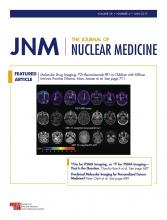TO THE EDITOR: Deandreis et al. aimed to compare two therapeutic interventions using radioactive iodine therapy in metastatic differentiated thyroid cancer (MDTC): the empiric “standard” activity (3.7 GBq) approach at Gustave Roussy (GR) and the dosimetric approach at Memorial Sloan Kettering Cancer Center (MSKCC) (1). Overall survival was selected for the study outcome measure. This was a retrospective investigation that required equal distribution of confounding factors in the cohorts to enable unbiased comparison of the two tested approaches. We would like to highlight several inconspicuous confounders that require the authors’ consideration and comment.
The GR cohort comprised mostly French women who, in general, had an approximately 22% lower overall probability of dying per 100,000 than the American women who made up most of the MSKCC cohort—84.92 in 1980, which gradually declined to 53.63 in 2010, as compared with 102.51 declining gradually to 77.16, respectively (2). Hence, the GR cohort had an inherent advantage over the MSKCC cohort in overall survival that needs to be recognized and addressed.
The GR cohort was younger than the MSKCC cohort, a difference for which the multivariate analysis attempted to correct. But Table 1 reveals the presence of another important confounder: inclusion of pediatric patients in both cohorts. Published experience from MSKCC shows 100% survival in pediatric patients with MDTC (3). This finding agrees with the widely recognized notion that the “biologic behavior of thyroid cancer can differ significantly between adults and children” (4). Most experts consider pediatric MDTC to be a different disease from adult MDTC. In survival studies, the two should be investigated separately, and, therefore, inclusion of pediatric patients in this study is a design error. Disappointingly, the exact numbers of pediatric patients per cohort were not disclosed. The younger median age of the GR cohort suggests that it probably had a greater proportion of pediatric patients, which would have guaranteed an overall survival advantage to the GR approach. Multivariate analysis cannot correct for this basic design flaw.
Another confounding variable that cannot be corrected for is the difference in patient preparation. GR used thyroid hormone withdrawal, whereas MSKCC used recombinant human thyroid-stimulating hormone (rhTSH). The authors conceded that “the effect of rhTSH vs [thyroid hormone withdrawal] preparation on [131I] efficacy still remains unknown.” However, the available observational evidence shows better radioactive iodine uptake and retention in metastatic lesions with thyroid hormone withdrawal than with rhTSH (5–7). This difference could also have given an overall survival advantage to the GR approach, if it depends on the effectiveness of radioactive iodine therapy.
Use of rhTSH in MDTC is off-label. The MSKCC practice of incorporating rhTSH into the routine dosimetry protocol is very rare, if not unique, but Deandreis et al. inappropriately extrapolated conclusions to the whole-body (blood clearance) dosimetric approach in general. Furthermore, some of the authors have previously disclosed relationships with the company that manufactures rhTSH (8). Off-label rhTSH use in the current report certainly requires at least a similar disclosure.
The above-addressed four deficiencies should be addressed by the authors, but are more than sufficient to show that this work failed to adequately balance confounders in the cohorts in favor of the GR approach. The results from the atypical (i.e., rhTSH stimulated) dosimetry protocol at MSKCC should not be generalized. Practitioners of the standard dosimetry-tailored, maximum-tolerated-activity approach can rest assured that there is still no evidence in the literature to equate the effectiveness of that approach to the one-size-fits-all empiric approach.
Footnotes
Published online Feb. 23, 2017.
- © 2017 by the Society of Nuclear Medicine and Molecular Imaging.







